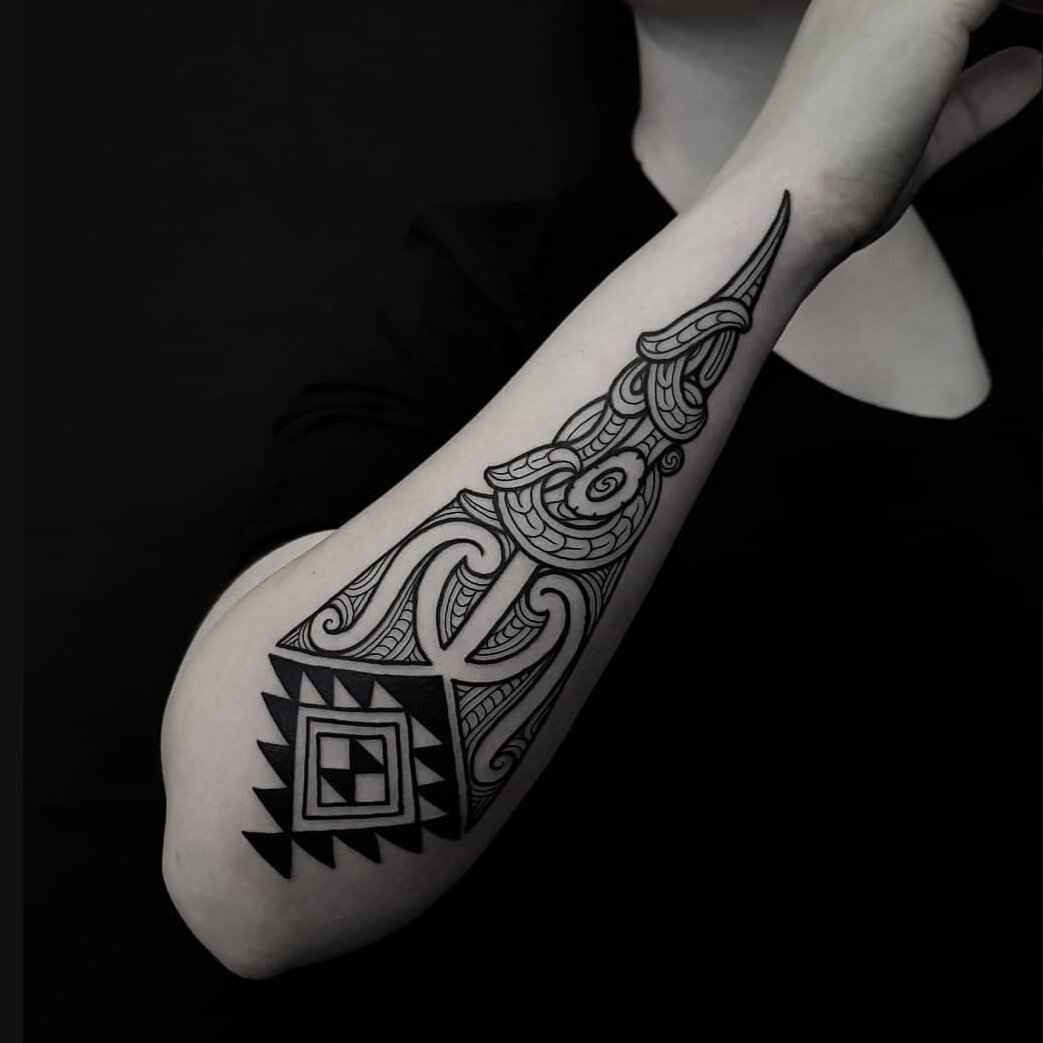Ta Moko
Ta Moko is the application of traditional Maori tattoo. Since it's revival from near extinction in the early 20th century, Tikanga (protocols) surrounding Ta Moko have changed. Traditionally applied using Uhi (chisels) Moko is now largely done using tattoo machines. Maori have always been quick to adapt to new technology; when steel tools became available in the 19th century, some of the most detailed Whakairo (carving) was produced. The same with Moko, the designs we use today have evolved from those of our ancestors and will continue to do so for generations to come.
Done by Fern Ngatai
What does contemporary Moko represent for the wearer?
Ta Moko has always been a visual interpretation of the wearer's Whakapapa (genealogy). Nowadays, people might have designs to represent family members, Kaitiaki (spiritual guardian) and milestones. For many Maori, Ta Moko is a way of expressing and connecting to their cultural identity. For non-Maori, the patterns can also represent family and tell a story of the wearers life and personality but they don't have the same connection to whakapapa as they do for Maori.
Who is allowed to wear Moko?
Being a practice so deeply rooted in Maori history and culture, Ta Moko must be approached respectfully, whether by Maori or Non-Maori. Anyone who is passionate about connecting with and immersing themselves in Maori culture should be able to wear a Moko. If someone is worried about cultural appropriation, it is always helpful to seek the advice of a Ta Moko artist so they can explain the significance of wearing traditional Maori patterns.
Done by Fern Ngatai
What is the Difference between Ta Moko and Kirituhi?
Ta Moko is seen by some as being a practice reserved for Maori only. After the revival of Maori tattooing there was more interest in the art form by Non-Maori and the term 'Kirituhi' was coined by Ta Moko artists. Kirituhi translates to 'skin art' and was a way of allowing non-Maori to wear traditional Maori patterns without the issue of cultural appropriation. Many artists still use the term Kirituhi when tattooing non-Maori recipients. Kirituhi, however has allowed non-Maori tattooers all over the world to imitate traditional Maori tattooing, using the label Kirituhi so as not to cause offence. Some Ta Moko artists maintain that traditional Maori Tattooing, whether done on Maori or non-Maori is Ta Moko. This way the art form holds its Mana or power and validity. It is up to the recipient of Ta Moko to uphold the Mana of the patterns they wear.
Each Ta Moko artist will have their own view on the Ta Moko/Kirituhi debate and practice each or both at their discretion.
Done by Fern Ngatai
Ta Moko Procedure
Ta Moko begins with a conversation between the artist and recipient. In this conversation, the meaning of the Moko will be decided, this might include using certain patterns to represent Whakapapa (genealogy) Family, Ancestors and tribal connections. The artist will then sterilise the skin being tattooed and begin drawing the design on. This is usually done with a number of pens to refine the design before it is tattooed.
Some Moko artists will recite a Karakia (prayer) to bless the work about to be done. This practice varies from artist to artist, it is not essential in every situation, usually less so in a tattoo shop. If Moko is being done under traditional protocol on a Marae (meeting house) a Kaumatua (elder) will usually open the ceremony with a Karakia and family members will continue with chants and song as the Moko is being applied.
A conversation with Thomas Clark about contemporary Ta Moko
Sunset Tattoo - What does contemporary Moko represent for the wearer?
Thomas Clark - Well, I'd like to think that Ta Moko today still represents what it did many generations ago. Since it's renaissance of the late 80s and 90s, Ta Moko has grown from strength to strength. Maori want to reconnect or express their own culture through Ta Moko, so the artists today still design Moko that connects the recipient to their tribes, family, ancestors, to the whenua (land) and so on. The only difference is that the art form has evolved to fit in todays era and is practiced with more contemporary tools and materials, but the ideals are still the same.
Sunset Tattoo - Who is allowed to wear Moko?
Thomas Clark - In todays day and age, we are trying to share Moko with the world, but obviously many Māori are receiving Moko to honour their culture and heritage just as many other Polynesian cultures are using their own traditional forms of tattoo to represent where they come from also. However, I also believe that it is not an entitlement and if you come seeking Moko with a negative or arrogant attitude, and if your heart is in the wrong place and you are mentally in the wrong frame of mind, then we artists reserve the right to deny working on you (Māori or non-Maori). If you look at the origins of Moko ( the story of Mataora and Niwareka ), you will see that to wear Ta Moko was also a reminder to be humble and respectful and not mistreat one another.
Sunset Tattoo - What is the meaning of 'Moko The World'?
Thomas Clark - Moko The World or #mokotheworld is a slogan,if you like, that I personally first heard from and interview that I saw online with Tohunga Ta Moko artist, Mark Kopua. (I am not 100% sure if he created that slogan, but he was the first I heard to say that, thats all). Some of us jumped on that slogan and since then have used #mokotheworld as a positive way to promote Ta Moko and share this taonga with the rest of the world.
Done by Thomas Clark
Done by Thomas Clark
Sunset Tattoo - Is it cultural appropriation for non-Maori to wear Moko?
Thomas Clark - When you consider such cases as the repatriation of Moko Mokai (preserved tattooed heads) and it's sensitive nature, you can understand why Maori have been more protective and apprehensive to share such a Taonga [treasure] as Ta Moko to the rest of the world. That being said, over the past 30 years, since its resurgence, Maori have been sharing Moko to the world, by way of Wānanga (workshops), Ta Moko symposiums and exhibitions,Tattoo Conventions and also out of our own personal Ta Moko/ Tattoo studio’s, hence the whole #mokotheworld expression.
Kirituhi was introduced and endorsed by some of the senior Ta Moko artists back around 1999 - 2000 after a discussion that arose about the mis-appropriation of maori art/culture by non Maori (ta moko included). Since then, Kirituhi has widely been accepted by non Maori and seen as a safe and respectful approach in receiving this form of skin art, indigenous to Aotearoa (New Zealand). The concept behind Kirituhi was to offer a less invasive or less insulting alternative form of Moko to non-Maori who really appreciated the aesthetics and skill that it takes to design. At the same time it would help to reduce the risk of insulting Maori who believed that non-Maori had already taken enough from us and couldn't Whakapapa back to Ta Moko.
Now not every Moko artist today agrees, to the concept of "Kirituhi" and would prefer to call their mahi "Ta Moko" wether it is done on Maori or Non Maori and that's fine also. I think it's important that each Ta Moko practitioner develops their own personal and ethical beliefs to adhere to, but for me personally, Kirituhi was a no brainer and ticked a lot of boxes, both culturally and ethically. And wether we like it or not, Kirituhi has grown and developed a Mauri of its own that just seems to be getting Stronger.
Sunset Tattoo - What is the place of Moko in Te Ao Maori today?
Thomas Clark - I guess if you consider where Ta Moko was sitting pre-renaissance era, then I’d have to say that Moko is in a much safer place and you can thank our more senior Tohunga Ta Moko artist’s like Derek Lardelli, Mark Kopua, Gordon Toi Hadfield, Ricky Manuel, Turumakina Duley, just to name a few of the earlier artists who helped work together as a collective to regain a lot of lost knowledge, due to the Tohunga suppression act that was enforced by the government back in 1907.
These artists faced a lot of adversity in the earlier days from both Maori and non-Maori, during their quest to revive the mauri of Ta Moko, so I personally have the utmost respect for these guys and I’m honoured to acknowledge them for it. Just like our Reo (language), Whaikorero (oratory), Whakairo (wood carving), Raranga (weaving), Mau Rakau (martial arts), Ta Moko can whakapapa to the gods and is a very important part of our culture and traditions.
Done by Tristan Marler
Done by Tristan Marler









